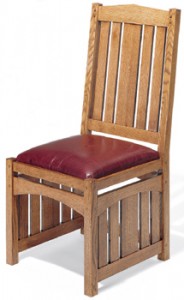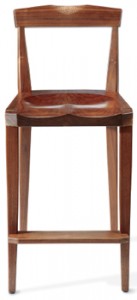 In a recent issue of our eZine, a reader wrote in to get some advice about building a chair. His question was rather specific, regarding the correct splay of the legs to maximize stability and strength. Tim Inman, an expert woodworker and finisher (and a wealth of helpful information!) and yours truly tried to offer this fellow some advice. Our answers took decidedly different approaches to a larger and broader topic of building chairs.
In a recent issue of our eZine, a reader wrote in to get some advice about building a chair. His question was rather specific, regarding the correct splay of the legs to maximize stability and strength. Tim Inman, an expert woodworker and finisher (and a wealth of helpful information!) and yours truly tried to offer this fellow some advice. Our answers took decidedly different approaches to a larger and broader topic of building chairs.
I hope he’ll forgive me for paraphrasing, but Tim’s response was something along these lines: Dive in there and build a chair! Whip out a prototype from some inexpensive lumber, experiment with the proportions and shape and see what you can learn from the experience. Then make a second chair really well and and burn the first one. Get over that fear of flying, and just do it.
My reply to the inquiry was more constrained: Find a good set of plans for a classic chair that you like, and learn from a proven design as you build it. Since chairs are a blending of ergonomics, engineering and style, the experience of other chair builders could be really beneficial.
After writing that reply and seeing it “out there,” it left me a bit unsettled with my approach. Tim was intending to inspire results, while I was trying to insure them.
In the time since, I’ve gone back to James Krenov’s The Impractical Cabinetmaker to find a quote that seems especially fitting in this context:
There are basically two different types of craftsman: the one who wants to be sure and for whom work is method and efficiency and predictable results; and the one who is the outsider, the person for whom there must always be an element of adventure, which is closely connected with uncertainty. For this craftsman, the most-used road leads to a fence.
 I’m not sure that I entirely agree with Mr. Krenov’s distinction here. I believe there are shades of gray between the two approaches to woodworking he describes: I think sometimes we are more adventurous in certain projects and calculated in others, depending on all sorts of factors — costs involved, time, intended purposes, safety, expectations of recipients, etc. But, his description does make me think about my own woodworking motivations. How often do I take the “most-used” road in order to get where I’m going with a project? What opportunities for adventure and learning could present themselves if I cut my own trail more often?
I’m not sure that I entirely agree with Mr. Krenov’s distinction here. I believe there are shades of gray between the two approaches to woodworking he describes: I think sometimes we are more adventurous in certain projects and calculated in others, depending on all sorts of factors — costs involved, time, intended purposes, safety, expectations of recipients, etc. But, his description does make me think about my own woodworking motivations. How often do I take the “most-used” road in order to get where I’m going with a project? What opportunities for adventure and learning could present themselves if I cut my own trail more often?
Food for thought…
Catch you in the shop,
Chris Marshall, Field Editor





